Thirty-six minutes. That’s all Atlas will give you, 36 minutes. Thirty-six minutes until a warhead, about three feet in diameter and almost seven feet tall traveling to Mock 5, would hit its target within 1,500 feet. But when you consider the nuclear blast radius plus fallout, 1,500 feet becomes negligible. Atlas—a tremendous scientific achievement with more support and funding than the Manhattan Project. The words “a great defense is a great offense” were sown into its blueprints and fear was its architect. Thirty-six minutes from launch to impact—and tremendous destruction.1 Back then, it was 36 minutes—36 minutes to say “Good-bye.”
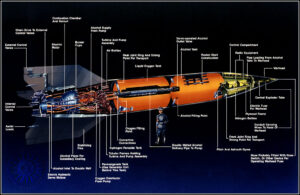
With conflict comes innovation, and what better conflict than World War II? World War II gave birth to the atomic bomb, but it also spawned another new type of weapon. Traditional weapons from that era were focused around a projectile and a launch mechanism, bullets and gunpowder, but the Nazis wanted something more destructive. The V-2, which stands for “Vengeance Weapon 2,” was a self propelled projectile with the capability of being controlled and directed to a target mid-flight through the use of radio waves. The range wasn’t that far, only around 150 miles, with a timeframe of five minutes to impact and a destructive ability of one-ton explosives. While the V-2 was an immense weapon, it was very small compared to what the United States would be working on after the war. Near the end of World War II, the Nazis had launched nearly 3,000 V-2 missiles in its attacks on England, France, and Belgium between September 1944 and March 1945. At least 700 rockets were produced monthly by concentration camp prisoners, located underground, to protect the rockets from bombing raids. The V-2 rocket proved to be a destructive weapon, but due to its poor accuracy, it targeted populated areas. In the end, it had killed about 7,000 people.2 After World War II ended, the V-2 rocket’s design was studied and was reconstructed by both the US and the USSR. The US recruited Wernher von Braun and other V-2 engineers that had surrendered at the end of the war. This would begin a new era of scientific discovery and fear of a new enemy.
The Cold War would be the next conflict to stir up innovation. There was a need for a weapon that could deliver an explosion, independent from ground signals. The Intercontinental Ballistic Missile (ICBM) was the “ultimate weapon.” The US, with the V-2 rocket and the experts behind it, found it essential to replicate and improve the design of the Nazi rocket. The first several US rocket tests were conducted in White Sands, New Mexico in 1949, and they used unmodified rockets and were slowly replaced with American-made parts to gain an understanding of the workings. Although the US was working on their own rockets, the USSR had a head start. The USSR had started development of their own rocket in 1947 called Rocket-1 (R-1). The first launch of the R-1 was in 1948, eleven years ahead of the US.3 The R-1 through R-5 rockets were a series of designs that modified some aspects of the V-2 rocket, such as increasing its thrust, having a larger rocket, and using integrated propellant tanks. While the USSR was developing more advanced rockets, the US had internal competition. The Army worked on rockets such as Redstone, Juno, Jupiter, and anti-aircraft missiles. The Navy had Aerobee, Viking, and ship-to-air and ship-to-ship missiles. The Air Force had long range missiles, including the MX-774 program which would eventually become the design plan for the Atlas ICBM.4
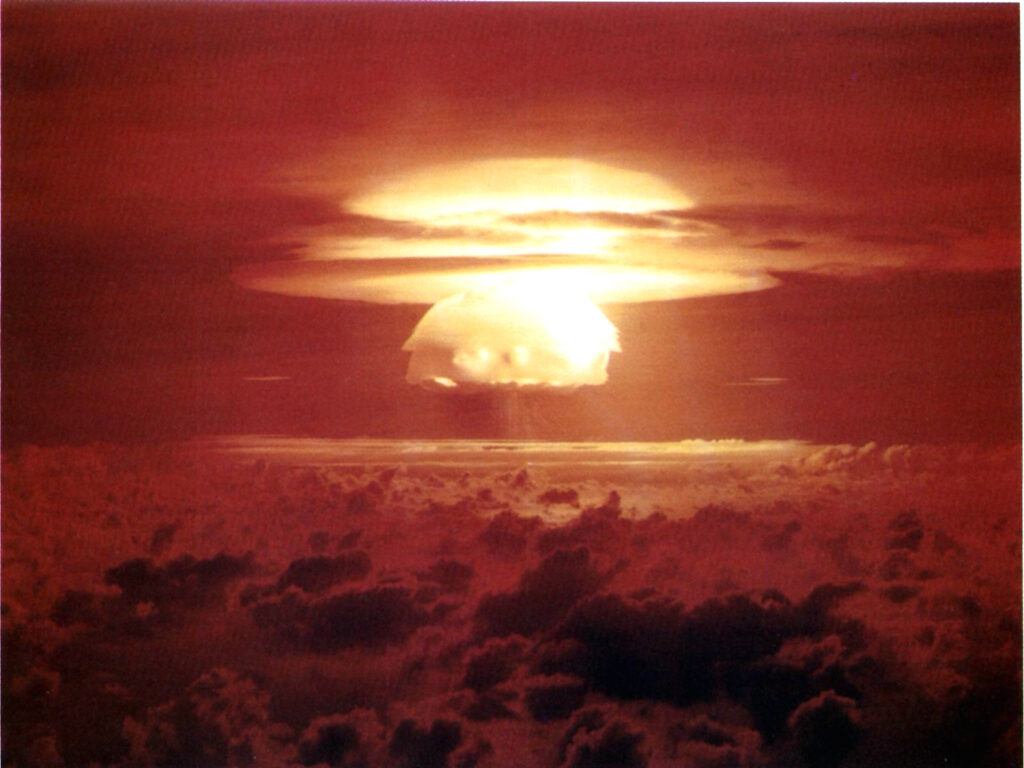
In 1954, the BRAVO test was the demonstration of a new hydrogen bomb, more powerful than the nuclear bomb that leveled Hiroshima and Nagasaki. The BRAVO test evaluated a deployable dry, hydrogen bomb on Bikini Atoll in the Marshall Islands in the Pacific Ocean. The predicted yield of the explosion was five megatons, but it ended up being 14.8 megatons, making it the largest US nuclear test and 1,000 times more powerful than the two bombs dropped on Japan in 1945. The fireball plume stretched about three miles in diameter within seconds. The resulting crater was more than a half-mile wide and several hundred feet deep.5
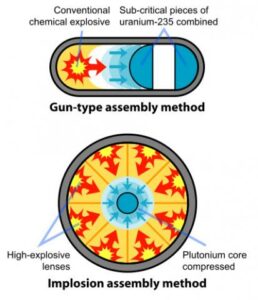
This thermonuclear bomb, also known as a hydrogen bomb or H-bomb, was a different type of bomb when compared to “Fat Man” and “Little Boy.” This new device, the H-bomb, used the process of fusion to generate an explosion, unlike nuclear bombs which use fission. The difference between fission and fusion is what is needed to happen to the atom to cause an explosion. Fission is when a heavy atom is split, which causes a chain reaction producing the explosion. The “Little Boy” and “Fat Man” bombs both achieved this process by two different methods: a gun-type assembly method and an implosion-type assembly method, respectively. A gun-type assembly uses two sub-critical pieces of Uranium-235 and shoves a plunger-shaped part into a hollowed out part using a regular explosive, causing both parts to come together. The effect caused the resulting total part to go critical, meaning that there was enough mass that a neutron resulting from a fission event would cause another fission event, and it would continue a chain reaction to happen, releasing more energy and neutrons to end up with an explosion. An implosion-type assembly uses a core of Plutonium-239 surrounded by explosives. When the explosives surrounding the core went off, the resulting explosion compressed the Plutonium-239 core, reaching critical mass and erupting to an explosion.6
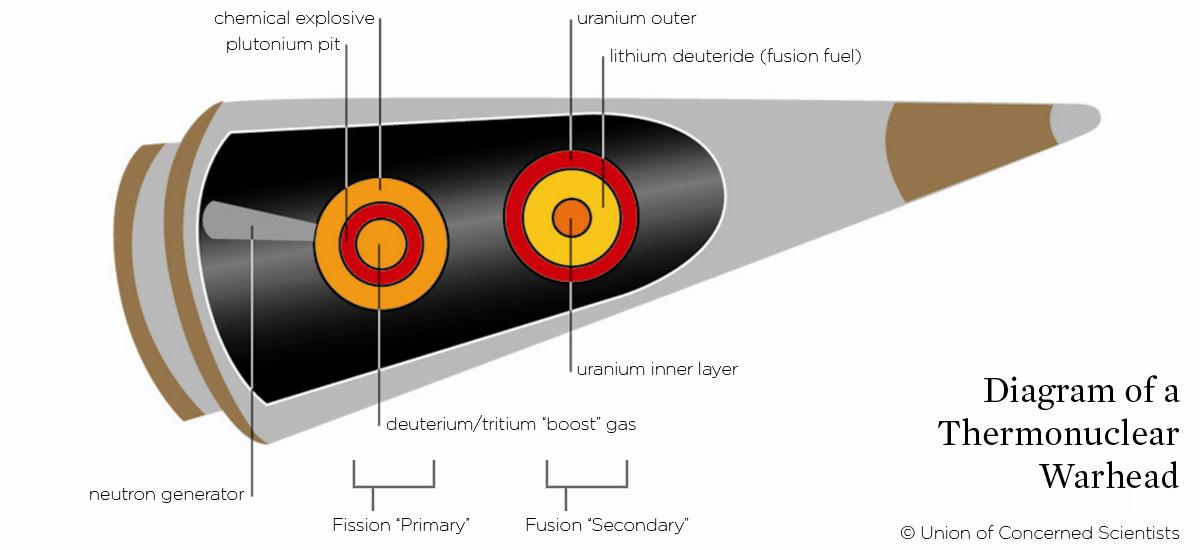
Modern nuclear weapons are of the implosion-type variety. Fusion is the opposite of fission. It is when lighter atoms fuse together to produce energy. The H-bomb utilizes fission to make fusion, which gives the bomb more power. The bomb is composed of two explosives: the primary, the fission, and secondary, the fusion. When the primary explodes, by being given neutrons from the neutron generator, the deuterium and tritium (isotopes of hydrogen) atoms inside of the explosion undergo fusion which generates more neutrons to increase the reaction. When the primary explosion compresses the secondary, the secondary reaches critical mass and then that explodes, which also contains hydrogen, which undergoes fusion to produce more neutrons, similar to how regular explosives would compress a nuclear core in the nuclear implosion-type bomb, but beefed up.7 This jump in innovation cut the weight of the soon-to-be warhead strapped to the Atlas from an estimated 7,000 pounds to 1,500 pounds.8
Although no one was living in the Bikini Atoll at the time of the BRAVO test, the blast from the BRAVO test affected the nearby islanders and fishermen with radiation. Several residents developed symptoms of radiation poisoning within days, such as burning, nausea, diarrhea, hair loss, and skin burns. Years later, the islanders developed thyroid tumors. In 1964, about ten years after the BRAVO test, the US government admitted responsibility for the radiation exposure and appropriated funds for the islanders.9
We had our silver bullet, now we needed a gun. In 1954, the Air Force formed a committee in order to lead the ICBM program, named the Strategic Missiles Evaluation Committee, code name Teapot Committee. The Teapot Committee would be in charge of every aspect of this rocket, from research and development, testing and evaluation, to production and deployment.10 The ICBM rocket was made a top priority by President Eisenhower, and the birth of the Atlas ICBM had begun.11
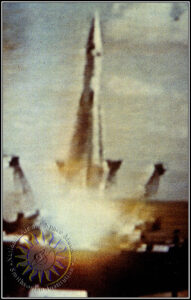
The Soviets had beaten us to it, though. The first launch of an ICBM, named R-7, was the work of the Soviets. The design was a modified version of the V-2, but it got the job done. The R-7 successfully took flight in August 1957 and proved to be powerful enough to place objects in orbit.12 The Soviets demonstrated their ability in October 1957, with a sound that terrified most Americans—a beep. Specifically, it was a beep that was orbiting Earth, with the name Sputnik I. The Space Race had begun, with the US far behind. But that wasn’t the whole story; it was just the one that was good for the public. The launch of the R-7 and the coming Space Race shifted the thinking of everyone. Publicly, it was to pit US intelligence and power against the Soviets, but privately it served as the testing grounds for the new generation of ICBMs. The new atomic bomb gave the US an ace up their sleeve.13
A series of rockets would be used in order to compete with the Soviet’s superiority in space. The Vanguard Test Vehicle 3 (TV-3), from the Naval Research Laboratory, was the descendant of the Navy’s Aerobee and Viking rockets, and was an attempt by the US to launch a satellite into space. The Vanguard TV-3 blew up on the launch pad on December 6, 1957. Jupiter-C was a modified Redstone missile built by the Army and designed by a team led by Werner von Braun. It launched successfully on January 31, 1958, with Explorer 1 being the first American satellite.14 Another success for the Jupiter-C was its nose cone. It was the first man-made object that survived a round trip to and from space. Jupiter-C did not go into orbit; however, it could survive the extreme heat of reentry and proved that a payload could be delivered.15 The US was slowly catching up to the Soviets, and in parallel, the ICBM design was being flushed out. The Space Race would continue with the creation of NASA and the development of several more rockets, such as the Scout-D, Atlas, and Titan.
The Atlas and Titan rockets were the first ICBMs for the US. For space travel, Atlas carried the Mercury spacecraft in 1962, carrying John Glenn into orbit as well as other space missions.16 The Titan ICBM became operational in 1962 and had the advantage of being stored in underground silos, although the first ICBM that would have this capability would be the Atlas F.17 Later, Titan II was created, and it was used to launch all ten of the Gemini missions in 1965 and 1966.
As always, with conflict comes innovation. The US was behind in ICBM technology—that was very much certain. The traditional deployment process involves a series of milestones or step-by-step procedures: study, develop, test, produce, and deploy, with each step being sequential.
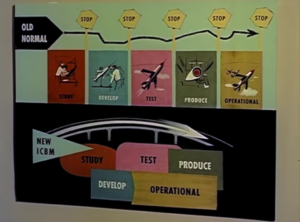
Unfortunately, the US did not have the time on their hands to go step by step, so the development of the ICBM overlapped steps in order to have something in the field in case Atlas was needed sooner. The new development track involved developing and studying the functionality of the rocket at the same time; they tested and produced different ICBM models, while some ICBM models were in deployment.18 There was not one type of Atlas ICBM. There were a series of rockets that tested specific attributes and improvements so that the next iteration would be more effective in delivering its warhead, and so that there would always be a supply of ICBMs on standby.
The failed start of Atlas began in April 1946, when the Army Air Force accepted a proposal from the Consolidated Vultee Aircraft Corporation, an airplane company formed from the merger of Consolidated Aircraft and Vultee Aircraft, unofficially known as Convair. The Consolidated Vultee Aircraft Corporation would later be officially known as Convair when it was bought by General Dynamics in March 1953. Convair was given the MX-774 project for their ICBM. The initial ICBM design was based on the V-2 rocket with major modifications, reduced weight, gimbaled engines, and a separable warhead. Unfortunately, there were budget cutbacks that led to canceling the MX-774 project entirely.19
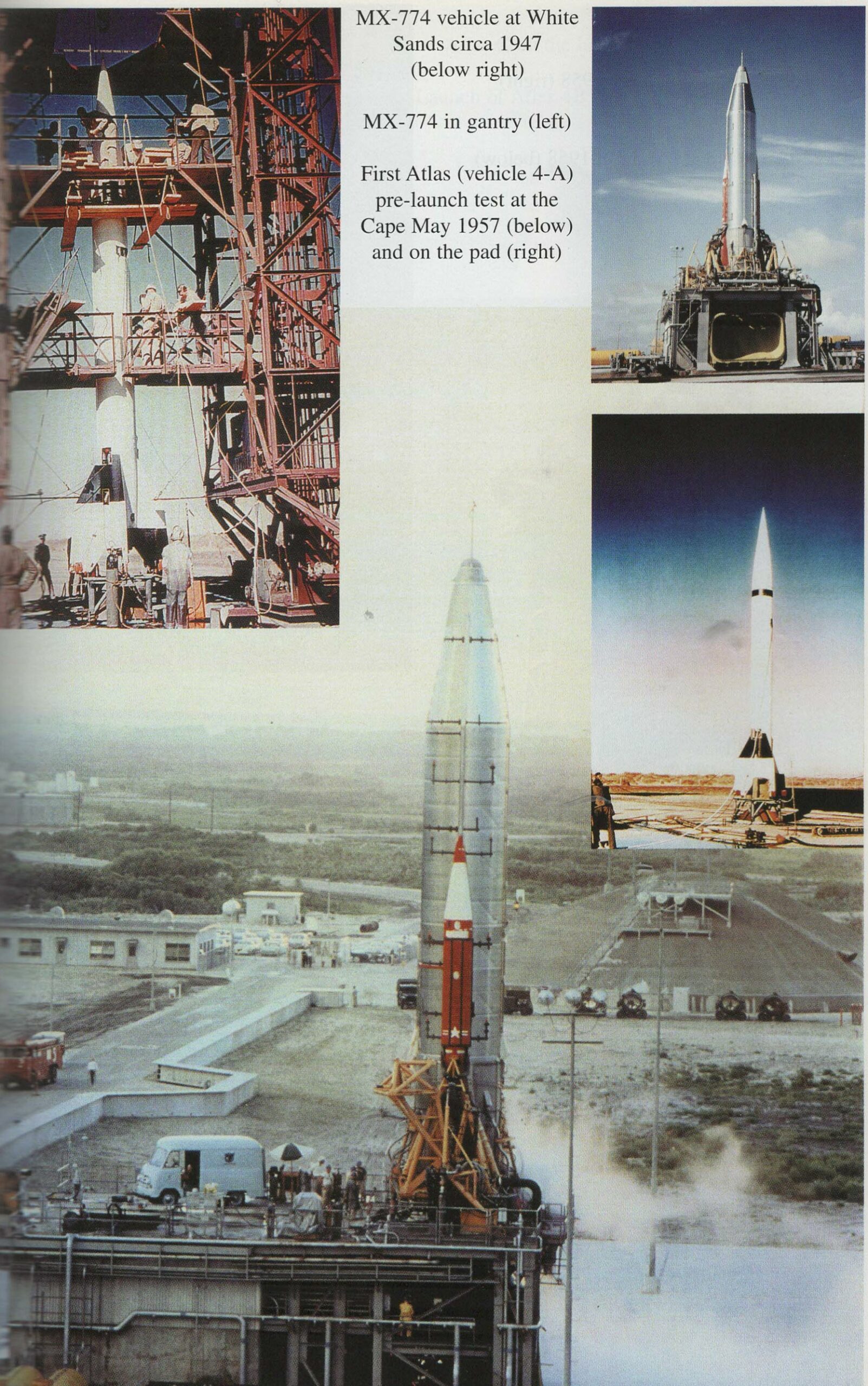
Convair wasn’t going to waste all their work for nothing, however. The Air Force allowed Convair to further develop three small missiles, each testing a different system, with the remaining money they had. These tests were conducted in White Sands, New Mexico during 1948 and 1949. The tests proved Convair’s innovations, with the missiles called Hiroc, but the Air Force still cancelled the project. Convair, over the next two years, would invest in the project themselves, ending up with $3 million dollars put into it.20 The Air Force came back to the ICBM in January of 1951 because of the Korean War, which happened from 1950 to 1953. It again asked Convair to design missiles for the new MX-1593 project. Convair finished their missile study in July that same year with the name Atlas. This weapon was originally designed to be 160 feet tall, 12 feet in diameter and be carried by five or seven large engines. It was estimated that Atlas would be operational by 1960, with the presumption that the series of milestones—study, develop, test, produce, and deploy—with each step being sequential, would be utilized.
In 1952, with new technologies being developed such as the new H-bomb in the then-upcoming BRAVO test, a revision of the ICBM program had to be made. The new revision estimated the Atlas ICBM would take ten years and cost approximately $378 million, and it was given 1-B development priority. Fortunately, with the new warhead being lighter, Atlas could be scaled down to accommodate for the weight difference. The design was now 110 feet tall, down from 160, and was now going to have five total engines, four of them would be first stage engines around a single larger engine. Then another modification to the Atlas program was made by the February 1954 Teapot Committee report, led by mathematician John von Neumann, which shrunk the development time by six to eight years. It wasn’t until May 14, 1954, that the Atlas program was bumped up to 1-A prioritization and the recommendations detailed by the Teapot Committee report were put into effect. As time moved on, the number of engines for Atlas was decreased from five to three, still keeping the idea of two small first stage rockets around one main engine. In the end, Atlas weighed in at 267,000 pounds, was 82 feet tall, with a range of 6,400 to 9,400 miles, and capable of carrying a 3,000 pound, 1-megaton warhead.21
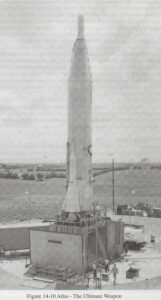
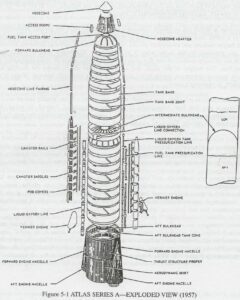
There were a total of six major ICBM designs: the Atlas models A, B, C, D, E, and F, with A-C being prototypes and D-F being deployed. Model A was a test rocket to test the two half-stage engines, and it began testing in June 1957 with only 2/8 successful flights of 600 miles. Model B was a more completed missile test, testing the half-stages, the main sustainer engine, and the detachable nose cone, which would be replaced with a real warhead when in service. Only one out of two was a successful flight, with the second flight reaching 6,000 miles. Atlas C was an improvement on B and was semi-operational; it launched successfully in December 1958. Atlas D and onward still required improvements, but due to the immediate need, they were still deployed. Atlas D had a radio guidance system that was tested in April 1959. During this time, three more Atlas Ds were made and put on operational alert at Vandenberg Air Force Base in late 1959. Atlas D was 75 feet tall, had a range of 5,500 miles and carried a 1.44 megaton warhead. Atlas E was refined from D with an improved guidance system and propulsion system; it was tested in February 1961. Both Atlas D and E had a response time of 15 minutes because it had to be fueled and prepped right before launch. The Atlas was fueled by liquid oxygen and kerosene, which made it difficult to maintain. Atlas F was an improvement on the fueling system, allowing it to be fueled and fire quickly, and had a response time of ten minutes. The F model was 82 feet tall and provided more destructive power than D and E, with 4.5 megatons of power. Models D and E were missiles that launched above ground and Model F was the first ICBM to be stored, not launched, in vertical silos. When Model F needed to be launched, the ICBM was first raised out of the silo and then launched.22

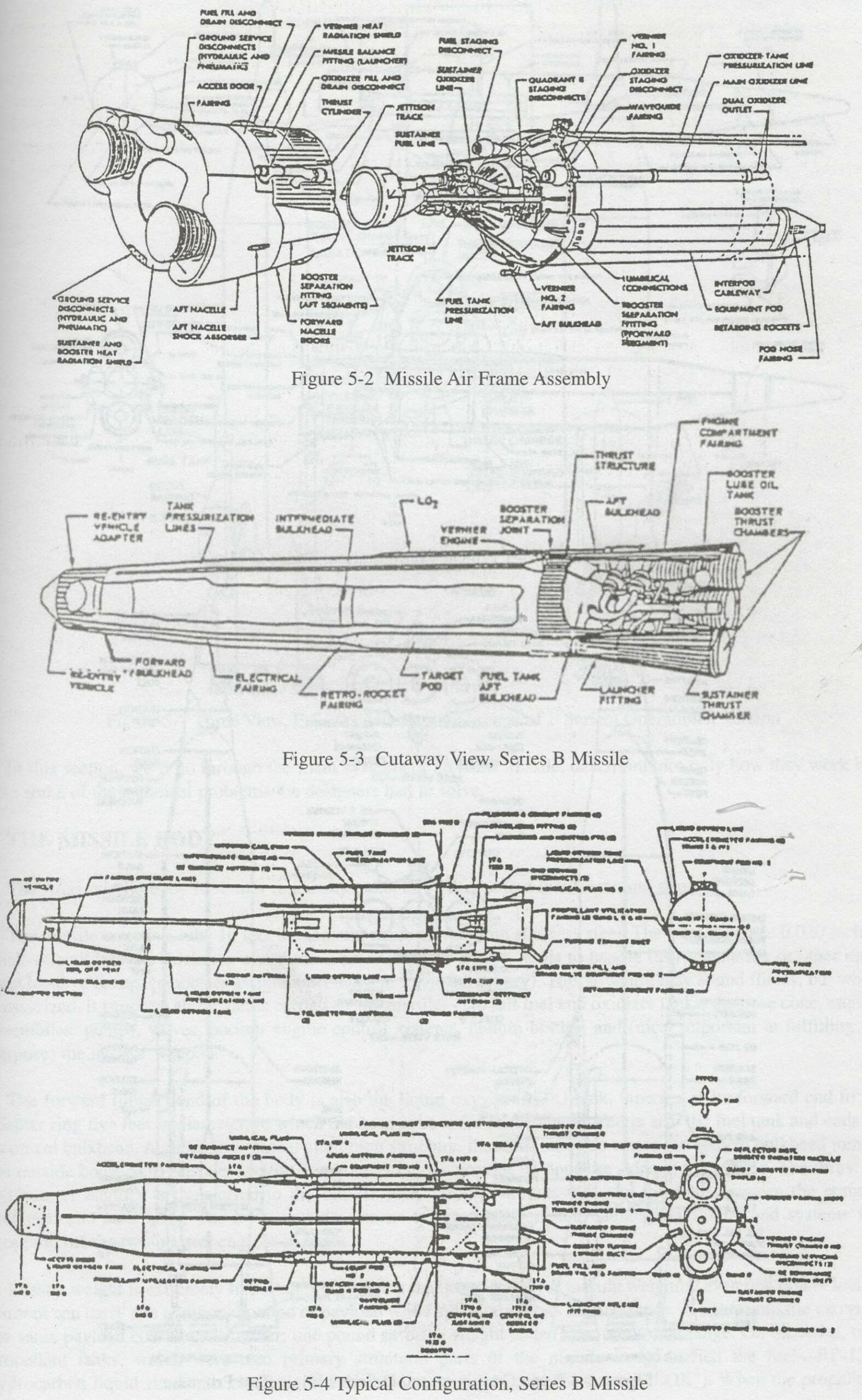
Due to the Soviet Union’s pace in ICBM technology, the Atlas had to be deployed into operation as soon as possible. The first batch of the Atlas D was the beginning, but the Air force wanted four squadrons of ten ICBMs, 40 in total. Then, to make matters worse, in December of 1957, the Department of Defense (DoD) expanded it to 13 squadrons of ten missiles. The DoD would only be able to get ten squadrons together. The first completed squadron of Atlas D was finished and operational in 1960 and consisted of a horizontal storage bay or “coffin” shelter, service, launch operations, guidance operations, generating plant, and communication buildings. When the ICBM needed to be launched, the storage bay roof would retract, then the ICBM would be rotated to a vertical position, fueled and then fired.23 Atlas F had three squadrons and didn’t need a guidance control building. Then later, the Atlas E would be deployed in six squadrons. Atlas E and F would get rid of the need for a storage building because now it could be stored in an underground silo, which provided more protection from enemy bombardment and living arrangements for the crew.
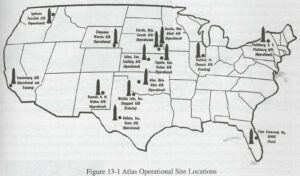
The total number of Atlas missiles in operation were 30 Atlas Ds, 28 Atlas Es, 72 Atlas Fs, and stationed at Air Force bases in California (six Atlas Ds and one Atlas E), Wyoming (15 Atlas Ds and nine Atlas Es), Nebraska (nine Atlas Ds and 12 Atlas Fs), Washington (nine Atlas Es), Kansas (nine Atlas Es and 12 Atlas Fs), Oklahoma (12 Atlas Fs), Texas (12 Atlas Fs), New Mexico (12 Atlas Fs), and New York (12 Atlas Fs).24

What is the fastest and most efficient way from point A to B? Falling—the answer is falling. Atlas is what is known as a stage-and-a-half rocket, meaning that it uses smaller rockets to get off the ground, then it uses its main stage to take it the rest of the way. There are multiple systems at play when Atlas is flying: there is a ground station that communicates to the rocket’s computers to gather information to determine location, speed, and angle; the Atlas rocket has a gimbal on its main stage, which it uses to both stabilize on lift off and to change direction to aim at target; and many other systems that provide system data and fuel consumption data. So, let’s go through a play by play of a launch with the assumption that an Atlas ICBM is already ready for launch. First, the ignition to take it off the ground, the half stage and the main stage are both fired in order to generate the lift the weight ratio needs to fly. After the main stage has burned enough fuel, making the rocket light enough for the main stage to lift on its own, the mini skirt of rockets is ejected, allowing the main rocket stage exhaust to gimbal. Now that the extra weight is gone, the rocket is now high enough to angle toward the needed direction from which the ground control computers are programmed to. This angle is crucial as it will be the determining factor on who will get hit.
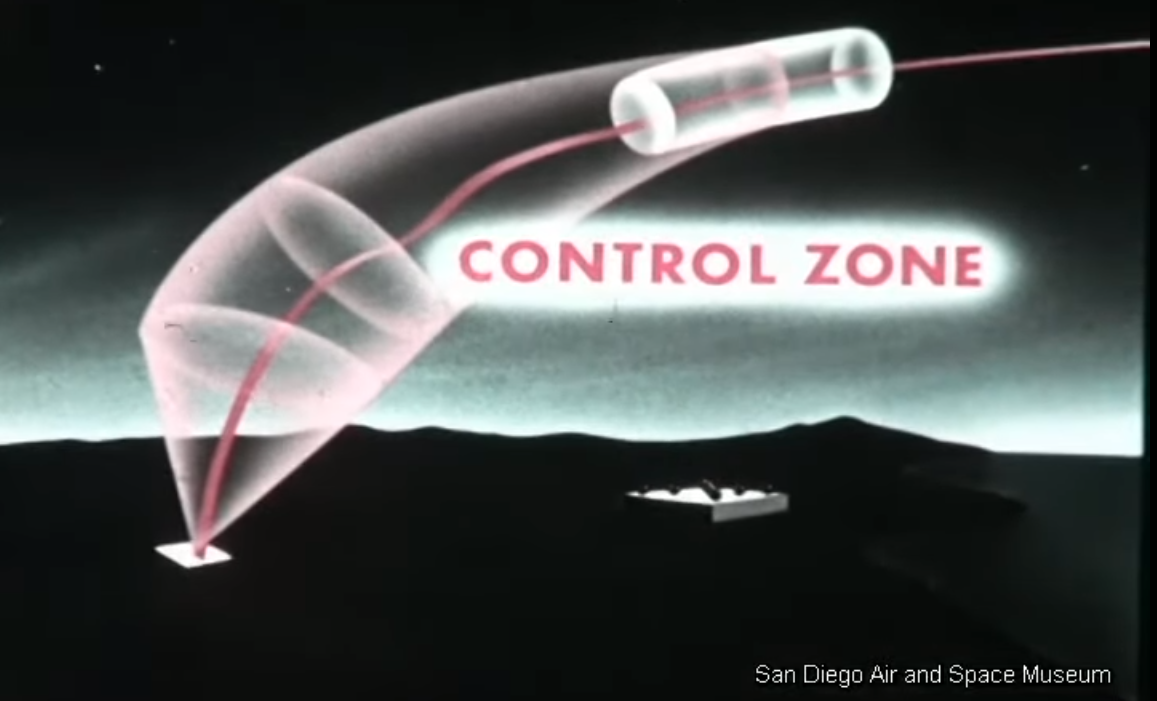
Let’s take a step back and think of the rocket as a catapult firing in slow motion—our projectile in our catapult is the warhead. In this scenario, our catapult is going in slow motion; we have the ability to rotate the catapult mid-fire and in turn, affect how our projectile will arc as it leaves the catapult. The moment the projectile leaves the catapult, there is no stopping it, and it is all up to the projectile and gravity. Going back to the Atlas ICBM as our catapult, the computers are calculating the angle the projectile needs to be at once it leaves the rocket. Correction commands are sent to the gimbal and the two smaller built-in engines in order to angle the rocket correctly. These smaller engines were called the Vernier control engines. The cutoff point for Atlas is the position where our catapult reaches the maximum point of movement and momentum is carried to the projectile. Once Atlas reaches the cutoff point, the warhead is ejected and armed and there is nothing stopping it but the earth. The time the computers had to correct Atlas was five minutes. After that, Atlas reaches the cutoff point where its engines shut down and it too falls with the warhead, not in the same arc, but it is discarded to the elements.
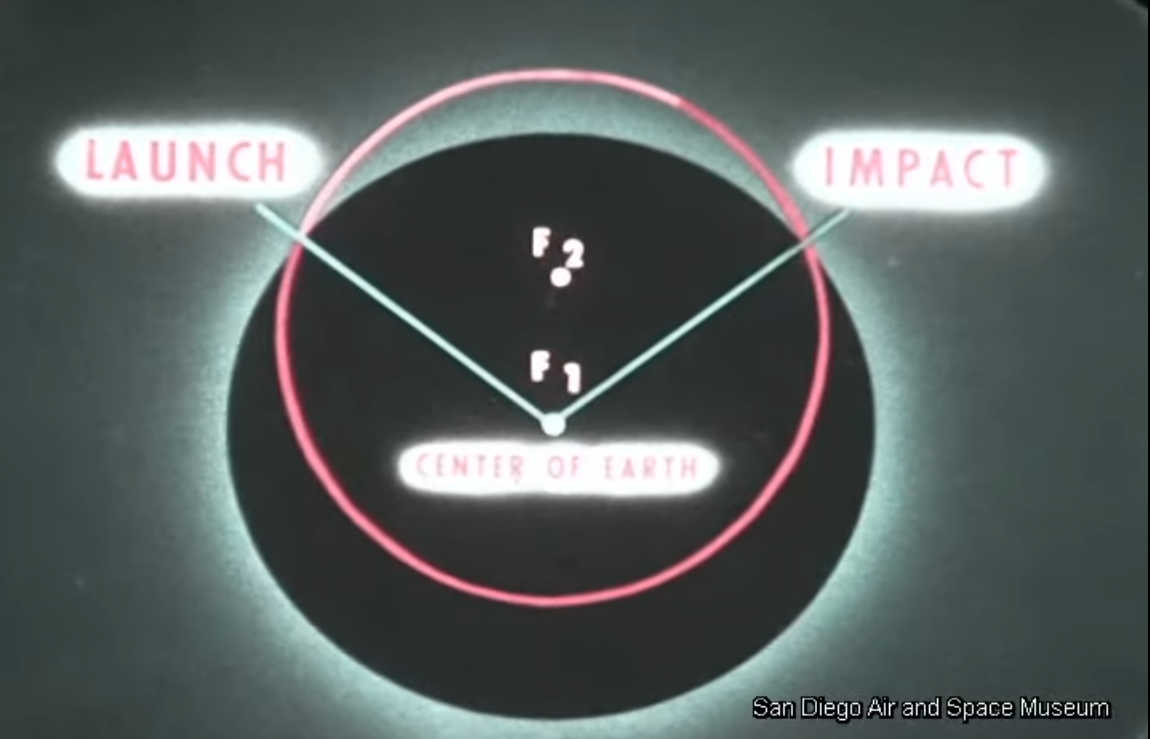
Now that the warhead is ready for action and falling toward its target, a small gyro stabilizer at the cylindrical tip kicks in to ensure it is pointing in the correct direction. Note that the warhead, once it leaves the rocket, is in a very thin or nonexistent atmosphere, and it is on its way toward a denser, more livable atmosphere. If this was a meteor, it would burn up in the atmosphere and humanity would know nothing of it. But this is not a meteor. The warhead is a nose cone scientifically shaped and built to withstand incredible heat and speed with the bonus of a bomb inside of it. By the time it reaches its target destination within a radius of 1,500 feet, its speed is around Mock 5, which would certainly pulverize anything and anyone under it, but it also is carrying an H-bomb, which would certainly destroy anything in a five to ten-mile radius.25 All of that, from point A to B, took 36 minutes.
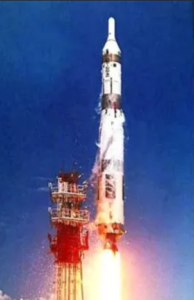
It’s always good to have a backup plan. The Titan I was an ICBM that was developed at the same time as the Atlas and was built in case the hurried development of Atlas ended in failure. Titan was a different type of missile when compared to the Atlas ICBM. Titan I was the first two-full stage ICBM and could deliver more damage to the target at a range of 6,300 miles. A major downside of the Titan I was that it took nearly 15 minutes to fuel the missile, and even though Titan I could be stored in an underground silo, it needed to be above ground and be vulnerable to attack when fueling.26 The first successful test launch of Titan I was in January 1960, and it would not be in operation until April 1962. The Titan I missiles were stationed at Lowry Air Force Base in Denver, Colorado. Because the Titan I was bigger than Atlas at 98 feet tall, it also packed a bigger punch. The missile could carry a W38 or W49 warhead, providing 3.75 or 1.44 megatons to its target.27 The next Titan, Titan II, was truly a titan. Standing at 103 feet tall and weighing 330,000 pounds, it is the largest ICBM that was in use by the US Air Force. Titan II could carry a warhead with a yield of nine megatons, “three times the explosive power of all the bombs used during World War II, including both atomic bombs,” and 30% of the Air Force’s destructive capabilities.28 Unlike Titan I and the Atlas ICBMs, Titan II could be stored with its liquid propellant, cutting the response time down to one minute. Although Titan II was a powerful missile, it did have its fair share of accidents, and for that reason, each site Titan II was stationed at, there was only one missile and each site was at least seven miles away from each other. The Titan I was operational from April 1962 to January 1965, and Titan II was operational from June 1963 to June 1987. After the Titan II had its time in service, NASA converted them for launchers to be used in the Gemini missions and Lockheed Martin would modify the Titan II for deploying US government satellites. Development on the Titan rockets would continue, but they would not be used as ICBMs because of the creation of more efficient missiles, replacing the need for Titan. Titan III was a set of launchers based on Titan II and would have a similar fate as Atlas. The upper stages, Centaur and Agena, were used on top of Titan III for missions that required escape from Earth’s gravitational pull, such as the Viking probes to the outer planets, the Voyager probes to Mars, and the Helios space probes to the sun. Titan IV would be more powerful than Titan III in that it could carry payloads up to 48,000 pounds to low-Earth orbit compared to 28,800 pounds that Titan III could carry to the same orbit. Titan IV would launch many satellites, both civilian and military, into space, including the Cassini-Huygens probe to Saturn in 1997. The last launch the Titan IV made was in 2005, when Atlas V would replace the Titan IV and Atlas III A and Atlas III B.29
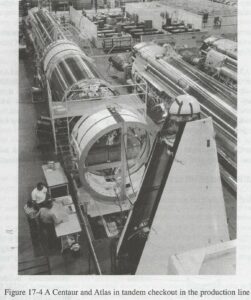
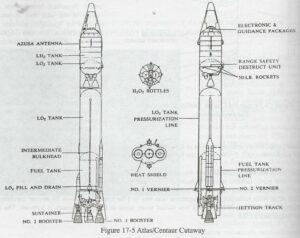
A machine without a purpose is nothing more than a paperweight; the only difference is how much paper it can hold. The Atlas ICBM was in operation from 1959 to 1965, but during this period and far after, to January 2005, Atlas would serve for other uses. Atlas, as an ICBM, had the six main designs, A-F, but Atlas as a rocket booster continued to be developed to 1995. Atlas would have more than 15 other versions that would carry upper stage rockets and a payload to space. Each version of Atlas would be an improvement from the previous one, such as being able to carry heavier satellites and carry manned spacecraft. Atlas was even used to launch the Surveyor missions to the moon.30 Development of the rockets would slowly shift from Convair to Lockheed-Martin as the use for the Atlas as an ICBM dwindled and was replaced with more fully developed ICBMs with improved systems and accuracy.
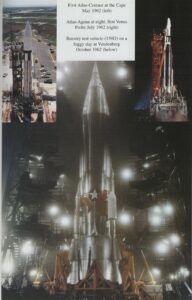
There were two commonly used upper stages for the Atlas booster, Centaur and Agena, and there was the Mercury upper stages, which would be used for manned flight. There was one other stage, the Able stage. However, this upper stage never worked successfully and was discontinued.31 Atlas flew four out of six Mercury missions, the Redstone rocket flew the other two missions, which were suborbital, and Atlas flew the orbital missions.32 The year 1978 would mark the end of the use of Atlas-Agea, while development of Atlas-Centaur would continue. In 1983, Atlas G and H were made and they produced larger amounts of thrust. The next Atlas rocket developed would not be called Atlas I, as in the letter ‘I’, but would be called Atlas 1 because they switched to roman numerals and removed the Vernier control engines.33 In 1991, Atlas II had all three engines being the same type, the RS-56, that provided a total of 2.5 meganewtons of thrust. The next major change would be in 1993 with the Atlas II AS, which was an Atlas II A with four Castor Solid Rocket Motors (SRM) capable of being jettisoned from Atlas.34 Atlas II A in 1992 had no change to the Atlas itself, but it had changes in the upper Centaur stage called Centaur II A, hence the name Atlas II A. There were 63 successful Atlas II launches from 1991 to 2004 and the last Atlas to be considered a stage-and-a-half rocket.35 On May 24, 2000, Atlas III was launched. It used a Russian made engine, Energomash RD-180, and was developed by Lockheed Martin, the two variants, two of Atlas III A and four of Atlas III B were launched until 2005, when they were replaced with the Atlas V.36
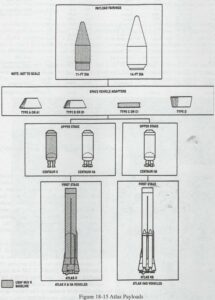
Now what happened to Atlas IV? A theory for the reason for skipping the name Atlas IV was because Lockheed Martin also had Titan IV when they had Atlas III, so the next rocket would combine attributes from Titan IV with Atlas III to form Atlas V.37 The new Atlas V rocket diverted from its previous models by no longer having a pressurized fuel tank and instead had a milled-out aluminum structure similar to the earlier Titan rockets, and can have up to five AeroJet SRMs attached around the core engine, making it capable of putting 10 to 19 tons into space.38 At this point, the Atlas rocket had evolved so much that it would be a far stretch to call the rocket an Atlas rocket. Future rocket designs that will replace the latest Atlas V and Delta IV rockets will have their names changed to Vulcan, which is currently in development by the United Launch Alliance. Vulcan replaces the Russian engines with the BE-4 Blue Origin Engine that uses liquid methane and liquid oxygen. The Vulcan development roadmap extends to 2035 with the expectation that Vulcan will be able to be reused similar to SpaceX rockets.39 In the end, Atlas flew a total of 582 flights, with a 83.3% success rate, and was in service for 48 years.40

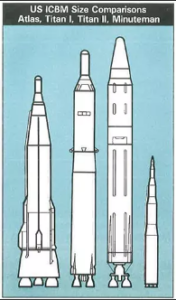
There is more than one way to skin a cat. The “then current solutions,” Atlas and Titan, would not be good enough in the new state of warfare, which could be seen as a worldwide Mexican standoff. What the US needed was a quick draw, an ICBM that was faster to respond and quicker to develop, and perform better than Titan and Atlas. The Minutemen would be the next best thing. Named after the Minutemen from the Revolutionary War, the Minutemen ICBM design was not like the Atlas nor the Titan, which both needed liquid fuel. The Minutemen was the first solid-fueled ICBM. It would work off the same technology as SRMs, but unlike the SRMs, which would be attached to a larger engine such as Atlas to help it take off in 1993, the Minutemen was a single missile. The new ICMB was in service at the height of the Cuban Missile Crisis on October 26, 1962. Because the Minutemen was a solid fueled missile, it could be stored for decades with little maintenance, and could be launched, from keys turned to ignition, within a minute.41 Other ICBMs would be developed, such as the Peacekeeper missile and a new ICBM, that is currently in development, the Ground Based Strategic Deterrent (GBSD). The GBSD is projected to be in deployment in the late 2020’s and would have a projected operational use to the year 2075.42
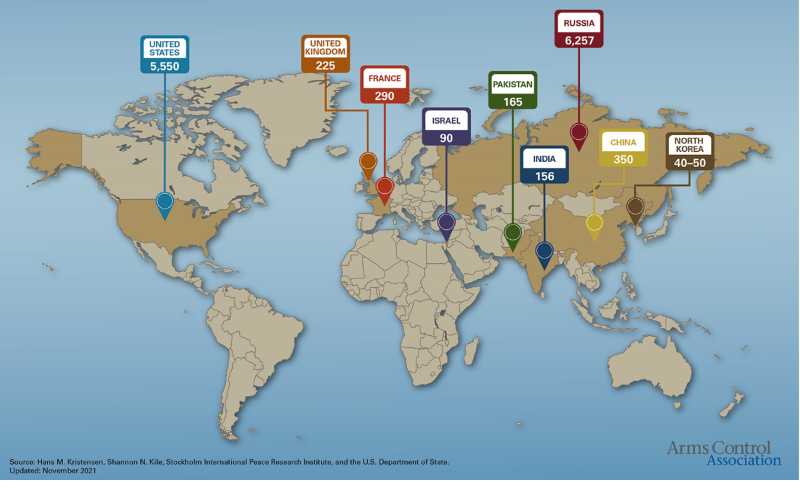
In the current day, the US and Russia are not the only ones with nuclear warheads. There are an estimated total of 13,080 nuclear warheads on Earth, with Russia and US in the lead. Other countries such as the UK, France, China, Israel, Pakistan, India, and North Korea, are also developing new and improved ICBMs to deliver their payload.43 Common day ICBMs are more efficient and have improved systems for better accuracy. The current ICBMs in deployment can reach their target within 30 minutes. Not only has the ICBM improved but the H-bomb also had improvements in its design. The BRAVO test was the United State’s attempt at an H-bomb. The Tsar Bomba was the Soviet Union’s attempt – it yielded 50 megatons which is three times more powerful than the BRAVO test and the most powerful nuclear test in history.44
With conflict, there is innovation, and sometimes that innovation opens up a Pandora’s Box of new conflict. The ICBM is the ultimate weapon designed to never be used, but used as a weapon of peace and a threat against war. The design of the ICBM went through many iterations and with each iteration came a more effective way to kill. With the creation of the V-2, warfare and the way we think about war changed drastically. As time moves on, the majority move on to different goals and the same happened to Atlas. Atlas’ purpose was to destroy, yet it slowly transitioned to other goals of space travel (and so did its brother Titan). Atlas took humanity to orbit, provided a new perspective of our place in the solar system, and even helped deploy satellites used to detect nuclear launches. Even though the majority has moved on from the fear of nuclear war, there is still the minority holding onto the keys of destruction, waiting for the time to respond. From conflict there can be new creations. Let us hope that humanity will never see the day where conflict leads to a new destruction.
- Atlas The ICBM (1957), 2022, https://www.youtube.com/watch?v=wndRKOF-9TQ, Atlas Progress Report To April 1954 HACL Film 00528, 2014, https://www.youtube.com/watch?v=D3BvAsTioSM. ↵
- “The V-2 Missile,” Air and Space (website), accessed January 23, 2023, https://airandspace.si.edu/exhibitions/space-race/online/sec200/sec210.htm, “V-2 Anatomy,” Air and Space (website), accessed January 23, 2023, https://airandspace.si.edu/exhibitions/space-race/online/sec200/sec211.htm ↵
- “A Jump Start in The Missile Race,” Air and Space (website), accessed January 23, 2023, https://airandspace.si.edu/exhibitions/space-race/online/sec200/sec213.htm. ↵
- “Rocket Rivalries,” Air and Space (website), accessed January 23, 2023, https://airandspace.si.edu/exhibitions/space-race/online/sec200/sec230.htm. ↵
- “The BRAVO Test,” Atomic Archive (website), accessed January 30, 2023, https://www.atomicarchive.com/history/cold-war/page-6.html. ↵
- “Science Behind the Atom Bomb – Nuclear Museum,” Nuclear Museum (blog), accessed March 24, 2023, https://ahf.nuclearmuseum.org/ahf/history/science-behind-atom-bomb/. ↵
- “How Nuclear Weapons Work,” Union of Concerned Scientists (website), accessed February 3, 2023, https://www.ucsusa.org/resources/how-nuclear-weapons-work. ↵
- “FEW Museum: Atlas (SM-65),” The Web Archive, May 9, 2008, https://web.archive.org/web/20080509071108/http://www.warrenmuseum.com/atlas.htm. ↵
- Graham Land, “America’s Disastrous Miscalculation: The Castle Bravo Nuclear Test,” History Hit (website), August 16, 2018, https://www.historyhit.com/americas-disastrous-miscalculation-the-castle-bravo-nuclear-test/; “Witness to Brilliant Blasts: When Night Becomes Day,” Naval History Magazine (website), August 2022, Volume 36, Number 4, accessed January 30, 2023, https://www.usni.org/magazines/naval-history-magazine/2022/august/witness-brilliant-blasts-when-night-becomes-day. ↵
- Atlas The ICBM (1957), 2022, https://www.youtube.com/watch?v=wndRKOF-9TQ. ↵
- “SM-65 Atlas,” Missile Threat (website), accessed January 20, 2023, https://missilethreat.csis.org/missile/atlas/. ↵
- “Launching The Space Age,” Air and Space (website), accessed January 23, 2023, https://airandspace.si.edu/exhibitions/space-race/online/sec200/sec250.htm. ↵
- Reggie Manning, “Air Force History of ICBM Development, Safeguarding America,” Air Force Global Strike Command (website), accessed January 20, 2023, https://www.afgsc.af.mil/News/Features/Display/Article/455710/air-force-history-of-icbm-development-safeguarding-america/. ↵
- “Jupiter-C,” Air and Space (website), accessed January 23, 2023, https://airandspace.si.edu/exhibitions/space-race/online/sec200/sec252.htm. ↵
- “An Advanced ICBM,” Air and Space (website), accessed January 23, 2023, https://airandspace.si.edu/exhibitions/space-race/online/sec200/sec271.htm; Chuck Walker and Joel Powell, Atlas: The Ultimate Weapon : By Those Who Built It (Apogee Books, 2005), 58. ↵
- “Atlas ICBM,” U-S History (website), accessed January 20, 2023, https://www.u-s-history.com/pages/h1956.html;“SM-65 Atlas,” Missile Threat (website), accessed January 20, 2023, https://missilethreat.csis.org/missile/atlas/. ↵
- “The Titan Missile (U.S. National Park Service),” National Park Service (website), accessed January 20, 2023, https://www.nps.gov/articles/titan-icbm.htm; Chuck Walker and Joel Powell, Atlas: The Ultimate Weapon : By Those Who Built It (Apogee Books, 2005),164-172. ↵
- “FEW Museum: Atlas (SM-65),” The Web Archive, May 9, 2008, https://web.archive.org/web/20080509071108/http://www.warrenmuseum.com/atlas.htm; Atlas The ICBM (1957), 2022, https://www.youtube.com/watch?v=wndRKOF-9TQ. ↵
- “FEW Museum: Atlas (SM-65),” The Web Archive, May 9, 2008, https://web.archive.org/web/20080509071108/http://www.warrenmuseum.com/atlas.htm; History of the Atlas Missile 10/1/1960 HACL Film 00177, 2014, https://www.youtube.com/watch?v=AjfqdYCPXpI. ↵
- History of the Atlas Missile 10/1/1960 HACL Film 00177, 2014, https://www.youtube.com/watch?v=AjfqdYCPXpI. ↵
- “FEW Museum: Atlas (SM-65),” The Web Archive, May 9, 2008, https://web.archive.org/web/20080509071108/http://www.warrenmuseum.com/atlas.htm; History of the Atlas Missile 10/1/1960 HACL Film 00177, 2014, https://www.youtube.com/watch?v=AjfqdYCPXpI. ↵
- “FEW Museum: Atlas (SM-65),” The Web Archive, May 9, 2008, https://web.archive.org/web/20080509071108/http://www.warrenmuseum.com/atlas.htm;Chuck Walker and Joel Powell, Atlas: The Ultimate Weapon : By Those Who Built It (Apogee Books, 2005), 189-199. ↵
- “FEW Museum: Atlas (SM-65),” The Web Archive, May 9, 2008, https://web.archive.org/web/20080509071108/http://www.warrenmuseum.com/atlas.htm. ↵
- “The Atlas Missile (U.S. National Park Service),” National Park Service (website), accessed January 20, 2023, https://www.nps.gov/articles/atlas-icbm.htm. ↵
- Atlas The ICBM (1957), 2022, https://www.youtube.com/watch?v=wndRKOF-9TQ; Chuck Walker and Joel Powell, Atlas: The Ultimate Weapon : By Those Who Built It (Apogee Books, 2005),50-65; Atlas Progress Report To April 1954 HACL Film 00528, 2014, https://www.youtube.com/watch?v=D3BvAsTioSM. ↵
- “Titan Rocket | Launch Vehicle | Britannica,” Britannica (website), accessed January 30, 2023, https://www.britannica.com/technology/Titan-rocket. ↵
- “The Titan Missile (U.S. National Park Service),” National Park Service (website), accessed January 20, 2023, https://www.nps.gov/articles/titan-icbm.htm. ↵
- “Titan II,” Astronautix (website), accessed February 3, 2023, http://www.astronautix.com/t/titanii.html. ↵
- “Titan Rocket | Launch Vehicle | Britannica,” Britannica (website), accessed January 30, 2023, https://www.britannica.com/technology/Titan-rocket. ↵
- Chuck Walker and Joel Powell, Atlas: The Ultimate Weapon : By Those Who Built It (Apogee Books, 2005), 243. ↵
- Chuck Walker and Joel Powell, Atlas: The Ultimate Weapon : By Those Who Built It (Apogee Books, 2005), 230-236. ↵
- Chuck Walker and Joel Powell, Atlas: The Ultimate Weapon : By Those Who Built It (Apogee Books, 2005), 243. ↵
- Chuck Walker and Joel Powell, Atlas: The Ultimate Weapon : By Those Who Built It (Apogee Books, 2005), 244. ↵
- Chuck Walker and Joel Powell, Atlas: The Ultimate Weapon : By Those Who Built It (Apogee Books, 2005), 244. ↵
- Chuck Walker and Joel Powell, Atlas: The Ultimate Weapon : By Those Who Built It (Apogee Books, 2005), 244-245. ↵
- “On Atlas’ Shoulders,” Lockheed Martin (website), October 3, 2022, https://www.lockheedmartin.com/en-us/news/features/history/atlas.html; Chuck Walker and Joel Powell, Atlas: The Ultimate Weapon : By Those Who Built It (Apogee Books, 2005), 245. ↵
- “Atlas 4 ????,” Nasa Space Flight (forum), Accessed March 19, 2023. https://forum.nasaspaceflight.com/index.php?topic=4478.0. ↵
- Chuck Walker and Joel Powell, Atlas: The Ultimate Weapon : By Those Who Built It (Apogee Books, 2005), 246-247. ↵
- “Vulcan Centaur Rocket: The Space Workhorse of Tomorrow | Space,” Space.com (website), accessed March 19, 2023, https://www.space.com/vulcan-centaur-rocket. ↵
- Chuck Walker and Joel Powell, Atlas: The Ultimate Weapon : By Those Who Built It (Apogee Books, 2005), 248-249. ↵
- “The Minuteman Missile (U.S. National Park Service),” National Park Service (website), accessed January 20, 2023, https://www.nps.gov/articles/minuteman-icbm.htm. ↵
- “Ground Based Strategic Deterrent (U.S. National Park Service),” National Park Service (website), accessed January 20, 2023, https://www.nps.gov/articles/gbsd.htm. ↵
- “Nuclear Weapons: Who Has What at a Glance | Arms Control Association,” Arms Control Association (website), accessed February 4, 2023, https://www.armscontrol.org/factsheets/Nuclearweaponswhohaswhat. ↵
- “Tsar Bomba: The Largest Atomic Test in World History,” The National WWII Museum | New Orleans (website), August 29, 2020, https://www.nationalww2museum.org/war/articles/tsar-bomba-largest-atomic-test-world-history. ↵
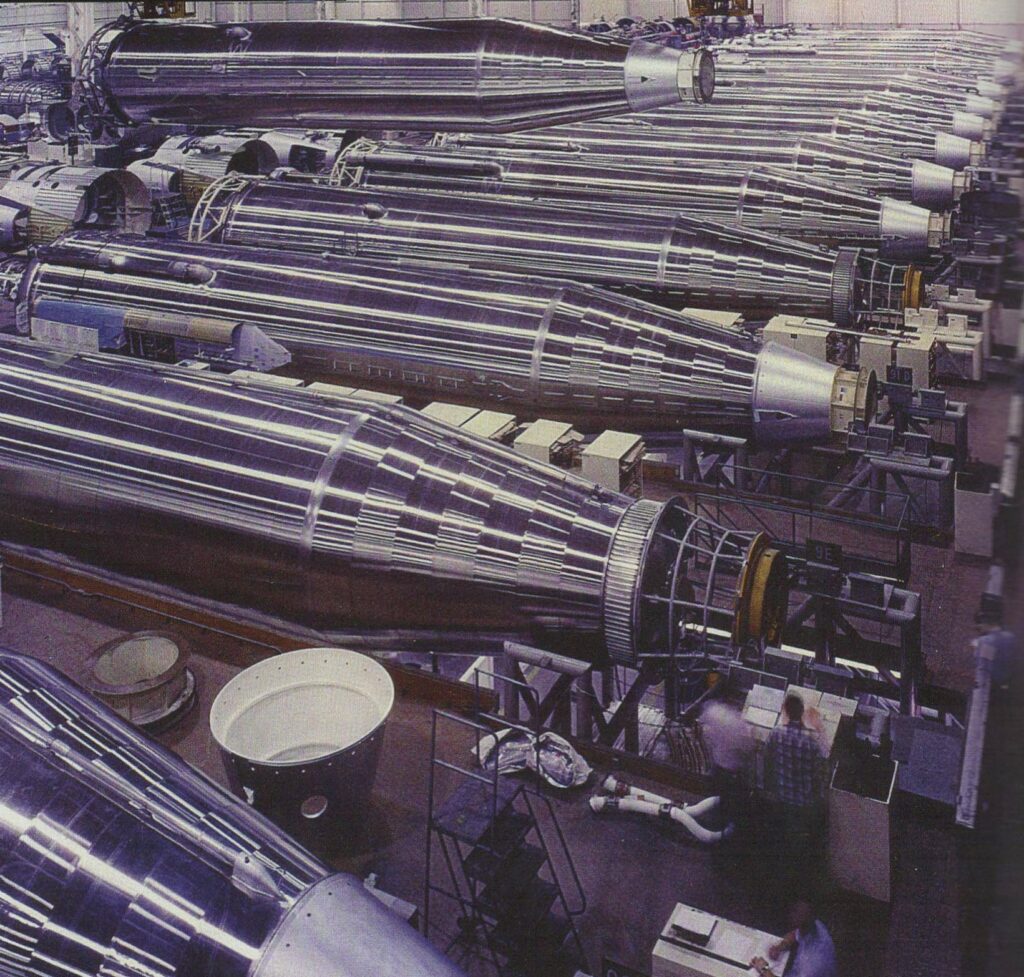


9 comments
Aaron Astudillo
Congratulations on the nomination and the creation of Rocket Science. It is well known that war often leads to inovations by man to ensure that the side that they work for wins. Thus, reading about its history and origins is interesting to read, and shines a light on the way that humankind can progress when placed in such a position.
Maximillian Morise
A fascinating article on the development of Rocket Science, but also on the birth of the Intercontinental Ballistic Missile and the implications it had on policy making. The images and also the descriptions used created a fascinating tale of scientific innovation and potential destruction. Congratulations on your nomination!
Peter Alva
This article was definitely a lot to take in. Not only was I interested in the history of Rocket science but I was more impressed by the article itself. You talk about it as if you’re a rocket scientist yourself sounds like an expertise in rockets almost. I enjoyed this article because you touch every base there is in this article. Congrats on the Nomination also!
Luke Rodriguez
This was a fantastic read! Also, congrats on the nomination! It was well-deserved. The article was well-written and detailed. This was a well-structured article, and I truly enjoyed reading this. I found it interesting that using the Atlas ICBM in the space program was a good thing, and the threat of it being used to deliver deadly atomic bombs is also, in its deterrent way, a good thing if it keeps the world from destroying itself.
Barbara Ortiz
Congratulations on your nomination for such a great article. I did not feel surprised when reading about the Soviets beating the US at several milestones in producing a rocket and the space race. Since they were on the time crunch, it seemed like their work to develop the ICBM was in line with Patton’s words: “A Good Plan, Violently Executed Now, Is Better Than a Perfect Plan Next Week.”
Alanna Hernandez
Vengeance weapon 2 sounds like one of the most metal things ever. If you ignore all the death and hatred it was made to complete.the rest of your article was very interesting to see the growing science behind the weapons that could possibly end humanity and any trace of it.Congratulations on your nomination in best publication in humanities. Well earned!
Jared Sherer
A very detailed and well researched article, this was also a very educational article. I was particularly interested in the details of the BRAVO test, on the Bikini Atoll in the Marshall Islands, since that’s where I was born, in the Marshall Islands, not far from the bomb site. The use of the Atlas ICBM in the space program was a good thing, and the threat of it being used to deliver deadly atomic bombs is also, in its own deterrent way, a good thing, if it keeps the world from destroying itself. The details provided by Mr. Poll of the development of the various types of rockets was fascinating. Anyone interested in the early development of ICBM’s would do well to read this article for a good start on the topic. Well done.
Marissa Rendon
Hi Ian congratulations on your nomination! This was a well structured article, and I truly enjoyed reading this. This seems to be a very educational article.
Danielle Sanchez
Congratulations on your nomination! This article was well written and informative! World War II gave birth to the atomic bomb, but it also spawned another new type of weapon. Traditional weapons from that era were focused around a projectile and a launch mechanism, bullets and gunpowder, but the Nazis wanted something more destructive. The V-2, which stands for “Vengeance Weapon 2,” was a self propelled projectile with the capability of being controlled and directed to a target mid-flight through the use of radio waves.